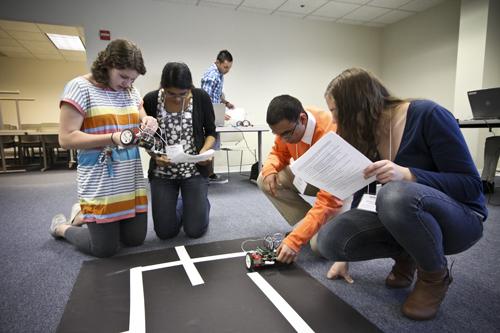
ASHBURN, Va. – About 150 high school students from across Loudoun County, Va. donned hazmat suits and tested earthquakes in workshops with science and engineering professors Friday at the Virginia Science and Technology Campus.
The sixth annual Science, Technology and Engineering Day looked to draw students in with an intimate look at the ongoing research on the campus that houses some of the University’s engineering and nursing programs.
“The idea is to get them hooked and encourage them to study science, engineering and technology. We just want to excite them to go into those fields,” assistant professor of engineering and applied science Pinhas Ben-Tzvi said. “It’s important to have outstanding students at this age to get excited about it and get advanced degrees in those fields because there’s a lot of need nowadays and it’s projected to be even more need in the future.”
Ben-Tzvi taught the basics of robotics to the students, who also shuffled to workshops on car crash test analysis and the future of energy.
Evan Smith, a student at Woodgrove High School, said the robotics workshop piqued his interested in electrical engineering.
“I’ve always liked to build things. I was definitely good with Legos,” Smith said. “It’s been neat to just get thrown into it.”
Another workshop showed the high school students how first responders protect themselves against fire or chemicals, but Scott Solomon said he tried to show students the hidden cost of emergency response as well.
“There are a lot of factors that people don’t consider, like the cost. These suits are $2,000 a-piece, single-use suits,” said Solomon, senior assistant director of GW’s Center for Preparedness and Resilience. “You also have heat stress. All of these suits put a huge burden to the cardiovascular system, and yes you’re protected from a chemical or biological agent, but you could have heat stress or heat stroke.”
Students wore gas masks and hazmat suits in a crash course of emergency response and introduced emergency scenarios to gauge which equipment was needed.
Former astronaut Frank Culbertson also delivered a keynote address about the future of space and science programs.




